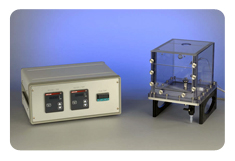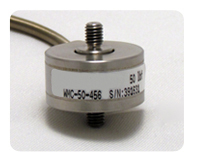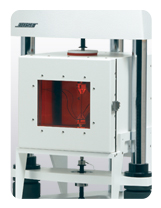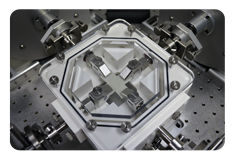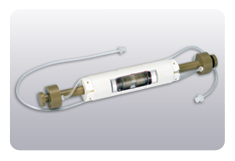Fixtures
Overview
ElectroForce bend fixtures are designed to provide simple, accurate fixturing for the testing of various specimens. The corrosion-resistant design allows use in saline and high temperature environments.
Key Features
- Corrosion-resistant design
- Both 3 and 4 point bend fixtures are available
- Lightweight design with minimal moving mass
- Can be used in submersible and non-submersible environments
- Rated for high temperature applications
- Adjustable upper and lower spans
- Available for all ElectroForce Model 3xxx, TestBench, and Biodynamic test systems
Environmental Chambers
Overview
TA Electroforce saline environmental baths are engineered to be easily configurable. These chambers feature removable front plates to allow easy access for installing specimens and a temperature control system to maintain a desired temperature. A removable top cover is also included to minimize fluid and heat loss.
Key Features
- Corrosion-resistant design
- Software controlled temperature control system
- Temperature range ambient to 45C
- Optical-grade polycarbonate chamber sides
- Flat sides design for imaging purposes
- Saline bath includes cover to minimize fluid loss
Saline baths are available for the following systems:
- ElectroForce 3100, 3200 and 3300 systems
- ElectroForce 3510 axial systems and axial/torsion systems
- ElectroForce LM1 TestBench and LM1 planar-biaxial systems
Overview
ElectroForce test instruments are oftentimes used to measure or control low-force applications. ElectroForce low-force axial transducers provide high accuracy, high resolution measurements for precise testing results.
Key Features
- The axial force cells are tension/compression transducers that have a welded stainless steel construction designed to minimize the effects of off-axis forces
- Load cells come pre-wired and gained for integration into an existing PCI control box
- Sensor calibration is included in the purchase of new cells
- Force sensors that are rated for the full capacity of the test system are calibrated according to ASTM E4 calibration procedures. This calibration process can be extended to many of the lower force sensors offered.
-
Sensors available from 250 g to 450 N. For higher force cells, refer to the High Force Axial Transducers page
Overview
A TA Electroforce hot/cold chamber upgrade adds the ability to test specimens in either cooled or heated environments on ElectroForce test instruments. The chamber is computer controlled allowing either static temperature conditions to be set, or temperature sweeps to be performed.
Overview
- Software controlled temperature control system
- Static and dynamic temperature control capable
- -150°C to +350°C temperature range
- Chamber cooling using a customer-supplied liquid nitrogen tank
- Integral heater included
- Chamber can be easily removed from the test instrument for other testing
- Hot/cold chambers are available for ElectroForce 3200, 3330 and 3500 test systems
BioDynamic Chambers
Overview
The BioDynamic bioreactor chamber provides a sterile, physiologically-relevant environment to mechanically stimulate samples. Researchers can perform multi-axial loading experiments including tension, compression, pulsatile distension, and torsion. This chamber can be used with TA Electroforce test instruments, including:
- 3200 ElectroForce test instrument
- TestBench instruments
- 5100 BioDynamic test instruments
- 5200 BioDynamic test instruments
Culture and test different sample sizes and types with a variety of fixtures.
Key Features
- Physiologically-relevant environment keep integrity of experiments with sterile cell culture media
- Meets a variety of research needs ability to use this chamber as a characterization, stimulation, and tissue growth solution
- Versatility can be used to evaluate and stimulate specimen including biomaterials, acellular and cell-seeded scaffolds, and native tissue samples
| Additional Information | |
|---|---|
| BioDynamic Chambers | Open Brochure |
Overview
The BioDynamic planar biaxial chamber is a sterile bioreactor designed for biaxial testing in the Planar Biaxial TestBench instrument. This chamber can be used for mechanical characterization and stimulation of soft tissues and biomaterials such as heart valves, pericardium, skin, 3D cell-seeded scaffolds, and more.
Key Features
- Physiologically-relevant environment characterize samples in a sterile environment and use a heating source to maintain 37
- Superior performance control specific experimental parameters, including dynamic load and displacement, in a bioreactor with low friction seals
- Designed for imaging a submerged top door eliminates bubbles so that samples can be imaged with a Digital Video Extensometer to accurately measure and calculate real-time strain values
- Scalability and versatility use the chamber for uni- or multiaxial testing with TA Electroforce grips or customer-supplied grips and fixtures
- High-quality, portable bioreactor the chamber can be easily moved in and out of the incubator and is autoclavable for multiple uses
| Additional Information | |
|---|---|
| BioDynamic Chambers | Open Brochure |
Overview
The BioDynamic MRI chamber allows researchers to study the structure, properties, and function of tissues or biomaterials within a sterile bioreactor. This chamber is compatible for use with a 35 mm bore, 9.4 Tesla MRI machine and TA Electroforce test instruments including:
- 3200 ElectroForce test instrument
- TestBench instruments
- 5100 BioDynamic test instruments
- 5200 BioDynamic test instruments
Samples can be mechanically loaded and perfused with cell culture media in the TA Electroforce test instrument, removed from the test frame and inserted into the MRI machine for imaging with continuous perfusion flow, and then returned to the test instrument for further mechanical loading and properties characterization.
The BioDynamic MRI chamber is appropriate for a variety of samples such as cartilage, bone, and tissue interfaces.
Key Features
- Integrated structural and functional characterization—stimulate, characterize, and image a single sample to get a cohesive understanding about these properties
- Real-time information—keep experiments going with real-time checkpoints showing the effect of mechanical stimulation and flow on tissue viability and cell differentiation
- Maintain sample viability—avoid disruption to the tissue or biomaterial by keeping it within a physiological environment while moving between the MRI and TA Electroforce test instrument
- Versatility—support different test types and flow patterns on a variety of samples


